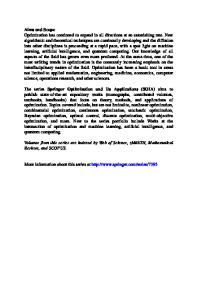Difference Methods for Solving Nonlocal Boundary Value Problems for Fractional-Order Pseudo-Parabolic Equations with the
- PDF / 254,019 Bytes
- 22 Pages / 612 x 792 pts (letter) Page_size
- 9 Downloads / 400 Views
rence Methods for Solving Nonlocal Boundary Value Problems for Fractional-Order Pseudo-Parabolic Equations with the Bessel Operator M. Kh. Beshtokov* Institute of Applied Mathematics and Automation, Kabardino-Balkar Scientific Center, Russian Academy of Sciences, ul. Shortanogo 89A, Nalchik, 360000 Russia Received May 31, 2018; in final form, November 13, 2019; accepted April 16, 2020
Abstract—This paper analyzes nonlocal boundary value problems for fractional-order pseudoparabolic equations with the Bessel operator with variable coefficients and difference methods for their solutions. To solve the considered problems, a priori estimates in differential and difference interpretations are obtained, which implies uniqueness and stability of solution with respect to the initial data and the right-hand side, as well as the convergence of the solution of the difference problem to the solution of the corresponding differential problem. DOI: 10.1134/S1995423920030039 Keywords: nonlocal boundary value problem, a priori estimate, difference scheme, pseudoparabolic equation, differential equation of fractional order, Gerasimov–Caputo fractional derivative.
INTRODUCTION Many works study pseudo-parabolic equations. Issues of filtering of liquids in porous media [1], heat transfer in heterogeneous environment [2, 3], and moisture transfer in soils [4], for example, lead to [5, p. 137] to modified diffusion equations, which are pseudo-parabolic partial differential equations. It is now obvious that many problems in physics and biology often involve media and systems that can be deemed as fractals. This applies, e.g., to polymeric materials [6] and highly porous media [7]. The first works on the theory of fractional order differential equations include studies by L. O’Shaughnessy and S. Mandelbrojt [8, 9]. In solving those problems it was necessary to explore boundary value problems for differential equations of fractional order [10, 11]. Monographs [12, 13] give a fairly complete overview of works on differential equations of fractional order. Monograph [12] considers qualitatively new properties of fractional integro-differential operators and their application to fractional order equations. Equations for transport in media of fractal geometry are considered in a number of interesting studies [14, 15]. In work [16], they propose and investigate mathematical models of water regimes in fractal-structure soil. These models rely on pseudo-parabolic differential equations with time fractional derivative. Papers [17–19] consider numerical methods for solving boundary value problems for a fractional diffusion equation. Results in [17] enable applying the method of energy inequalities to obtain a priori estimates for boundary value problems for a fractional order equation in differential and difference interpretations, as well as in the classical case (α = 1). Work [20] considers the nonlocal boundary value problem for the equation Lν (u) ≡ ut − uxx − νuxxt + c(x, t)u = q(x, t) that meets the following conditions: *
E-mail: [email protected]
219
Data Loading...











